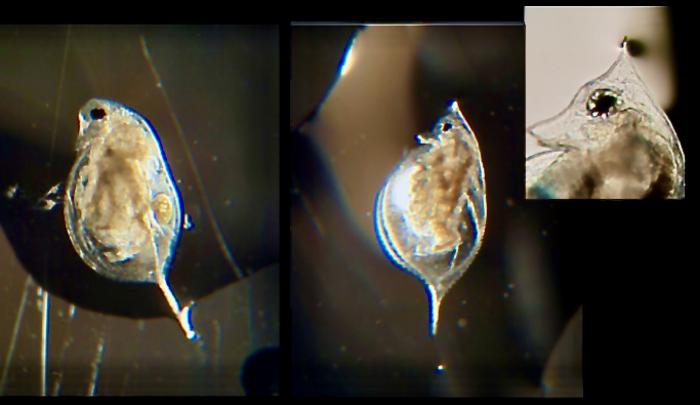Kyoto, Japan — Life for the common water flea Daphnia must be tough. As a favorite meal choice for aquatic predators, they may need to make some creative morphological or behavioral changes for survival.

Credit: KyotoU/Hideyuki Doi/Mariko Nagano
Kyoto, Japan — Life for the common water flea Daphnia must be tough. As a favorite meal choice for aquatic predators, they may need to make some creative morphological or behavioral changes for survival.
By modifying their body shape, size, and reproduction, Daphnia has demonstrated adaptive resilience. However, while Daphnia is a model species for studying phenotypic plasticity, the precise relationship between the prey’s body size and their predator’s size preference has not been established.
Now, a group including two universities in Kyoto has determined that prey size and risk of predation are strongly related to the medium-sized Daphnia — a small, planktonic crustacean — targeted by aquatic insects and fish.
“This phenotypic plasticity has been shown to be expressed by a variety of factors, including predator type, predator mode, and density,” says corresponding author Mariko Nagano of the Kyoto University of Advanced Science.
The two predator types of Daphnia are typically Chaoborus larvae — also known as phantom midge — which prefer smaller prey, and fish, which prefer larger prey as they tend to hunt visually.
Collaborating in the study, Toyama Prefectural University and Kyung See University jointly conducted the team’s meta-analysis of experiments on phenotypic plasticity. Results from the team’s collective effort suggested that medium-sized Daphnia would likely be the most vulnerable to predation among its genus by both predator types and therefore have the most defensive strategies.
The meta-analysis also suggests that the larval predators impose a greater influence on Daphnia‘s morphological change than do fish.
Overall, the small and medium-sized Daphnia expressed the highest degree of predator-induced plasticity, which the team found was more evident in small Daphnia than would be expected from size-selective predation.
“The body size of Daphnia is a key trait influencing its plasticity expression and evolution,” concludes co-author Hideyuki Doi of Kyoto University’s Graduate School of Informatics.
###
The paper “Predator-induced plasticity in relation to prey body size: A meta-analysis of Daphnia experiments” appeared on 8 June 2023 in Freshwater Biology, with doi: 10.1111/fwb.14108
About Kyoto University
Kyoto University is one of Japan and Asia’s premier research institutions, founded in 1897 and responsible for producing numerous Nobel laureates and winners of other prestigious international prizes. A broad curriculum across the arts and sciences at undergraduate and graduate levels complements several research centers, facilities, and offices around Japan and the world. For more information, please see: http://www.kyoto-u.ac.jp/en
Journal
Freshwater Biology
DOI
10.1111/fwb.14108
Method of Research
Meta-analysis
Subject of Research
Animals
Article Title
Predator-induced plasticity in relation to prey body size: A meta-analysis of Daphnia experiments
Article Publication Date
8-Jun-2023
COI Statement
The authors declare no conflicts of interest.




